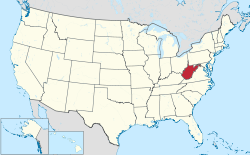Preston County | |
|---|---|
Preston County Courthouse | |
 Location of Preston County in West Virginia | |
 West Virginia's location within the U.S. | |
| Coordinates: 39°28′N79°40′W / 39.47°N 79.67°W | |
| Country | |
| State | |
| Founded | January 19, 1818 |
| Named after | James Patton Preston |
| Seat | Kingwood |
| and Largest city | |
| Government | |
| • Commission President | Samantha Stone (R) [1] |
| • County Commission | Don Smith (R) [2] Hunter Thomas (R) [3] |
| Area | |
• Total | 1,690 km2 (651 sq mi) |
| • Land | 1,680 km2 (649 sq mi) |
| • Water | 6.7 km2 (2.6 sq mi) 0.4% |
| • Rank | 8th |
| Population (2020) | |
• Total | 34,216 |
• Estimate (2021) | 34,358 |
| • Rank | 15th |
| • Density | 20.4/km2 (52.7/sq mi) |
| Time zone | UTC−5 (Eastern) |
| • Summer (DST) | UTC−4 (EDT) |
| Area codes | 304, 681 |
| Congressional district | 2nd |
| Senate district | 14th |
| House of Delegates district | 83rd, 84th |
| Website | http://www.prestoncountywv.org/ |
Preston County is a county located in the U.S. state of West Virginia. As of the 2020 Census, the population was 34,216. [4] Its county seat is Kingwood. [5] The county was formed from Monongalia County in 1818 and named for Virginia Governor James Patton Preston. [6]
Contents
- History
- Geography
- Major highways
- Adjacent counties
- National protected area
- Demographics
- 2020 census
- 2010 census
- Politics and government
- Federal politics
- State politics
- County government
- Communities
- City
- Towns
- Magisterial districts
- Census-designated place
- Unincorporated communities
- See also
- References
- Further reading
- External links
Preston County is part of the Morgantown, WV Metropolitan Statistical Area, and is the southernmost county of the Pittsburgh media market. It is the home of The Buckwheat Festival, a county fair known for making buckwheat pancakes. [7]






